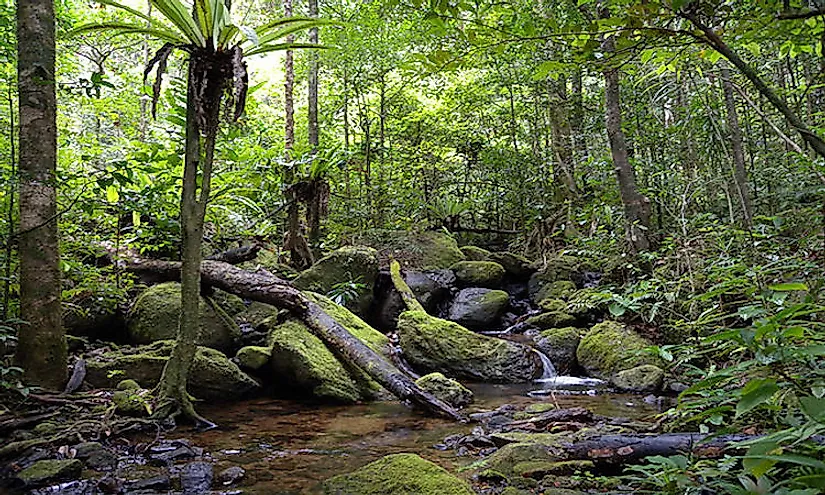Ecological Regions Of Madagascar

Madagascar’s high levels of endemism are supported by its many rivers, coastlines, wetlands, forests, and shrubs. The island of Madagascar stretches for a total area of 226, 658 square miles of the Indian Ocean and it is the world's fourth largest island. Due to long periods of isolation from mainland Africa, Madagascar is home to unique habitats and rare flora and fauna.
Ecological Regions Of Madagascar
Madagascar Subhumid Forests
The Madagascar subhumid forests ecoregion is classified in the tropical moist broadleaf forests Biome. The ecoregion covers areas in the central highlands of the country from altitudes of 900 meters. Isolated patches of the ecoregion occur in the northern highlands, Andringitra and Ankaratra massifs, Amber Mountain and select wetlands including Lake Alaotra. Annual precipitation is recorded at 1,500 mm although some regions receive as much as 2,000 mm and as little as 600 mm annually. Large expanses of grasslands characterize the area's vegetation alongside introduced acacia and eucalyptus tree species. There are isolated patches of woodlands, dominated by the tapia tree species. The region was formerly home to numerous endemic species which are now extinct due to human impact. Notably, the ecoregion is home to the critically endangered Alaotran gentle lemur. Bird species include Madagascar snipe, Brown emutail, cryptic warbler, and Appert’s greenbul. The region is continually threatened by agricultural expansion, fire, alien plant and animal species, over exploitation, and pollution of wetlands. The Ranomafana and Marojejy national parks and Ambohitantely and Ambohijanahary forest reserves have been established in the ecoregion.
Madagascar Dry Deciduous Forests
The Madagascar dry deciduous forests ecoregion is classified under the tropical and subtropical broadleaf forest Biome. This ecoregion covers western and northern parts of the country. The ecoregion is recognized for its tsingy limestone karst massifs. The rest of the landscape is characterized by forests, lakes, grasslands, and wetlands. Annual rainfall is recorded from 1,000 mm to 1,500 mm between the months of October to April. Dominant tree species include the baobab, Moringa, and flamboyant tree. Notable animal species are the endangered Angonoka tortoise, giant jumping rat, golden-crowned sifaka, fossa, and multiple lemur species. Habitat degradation, logging, excessive grazing, fires, and pollution are some of the threats to the region. Numerous conservation areas have been established including the Bora, Ankarana, and Maningoza Reserves, and the Ankarafantsika National Park.
Madagascar Mangroves
The Madagascar mangroves is ecoregion along the western coastline of the country. The region is also situated in the estuaries of numerous freshwater rivers. Annual rainfall ranges from 350 mm to 2,000 mm. Thickets of mangrove trees act as a haven for migratory bird species, home to important bird species, critical in stabilizing lagoon shores, and crucial in the filtration of nutrients.
Notable avifauna found in the region includes the endemic Madagascar fish eagle, African spoonbill, Madagascar heron and great white egret alongside populations of crocodiles, turtles, and fish species. The Madagascar mangroves are susceptible to threats such as urban development, pollution, soil erosion, excessive fishing, and logging. The Mananara Biosphere Reserve was established to protect the region’s biodiversity.
Madagascar Succulent Woodlands
The Madagascar succulent woodlands ecoregion is classified in the deserts and xeric shrublands Biome. The ecoregion cover's the country’s southwestern area, and it is characterized by both deciduous forests and succulent desert-adapted plants. Annual average rainfall recorded is between 575 mm and 1,330 mm during the wet months of November to April. Xeric plant species dominate the landscape including the families Sapindaceae and Euphorbiaceae and baobab species. Notable fauna includes the flat-tailed tortoise, narrow-striped mongoose, giant jumping rat and several lemur species. This ecoregion is threatened by fire and logging. Protected areas include the Kirindy Mitea National Park, Andranomena Reserve, and Kirindy Forest Reserve.
Other Ecological Regions Of Madagascar
The freshwater ecoregions are Eastern Highlands, Eastern Lowlands; Southern Basins; Northwestern Basins and Western Basins. The Western and Northern Madagascar Coastal Waters and the Southeast Madagascar Coastal Waters ecoregions are classified in the Western Indian Ocean Marine Biome. The rest of the ecological regions are Madagascar ericoid thickets; Madagascar lowland forests and the Madagascar spiny thickets or Madagascar spiny forests.
Ecological Regions Of Madagascar
| Ecological Regions of Madagascar | Biome |
| Eastern Highlands | Freshwater |
| Eastern Lowlands | Freshwater |
| Madagascar dry deciduous forests | Tropical Dry Forests |
| Madagascar ericoid thickets | Montane Shrublands |
| Madagascar lowland forests | Tropical Moist Broadleaf Forests |
| Madagascar mangroves | Mangroves |
| Madagascar spiny thickets or Madagascar spiny forests | Xeric Shrublands |
| Madagascar subhumid forests | Tropical Moist Broadleaf Forests |
| Madagascar succulent woodlands | Xeric Shrublands |
| Northwestern Basins | Freshwater |
| Southeast Madagascar Coastal Waters | Western Indian Ocean Marine |
| Southern Basins | Freshwater |
| Western and Northern Madagascar Coastal Waters | Western Indian Ocean Marine |
| Western Basins | Freshwater |











